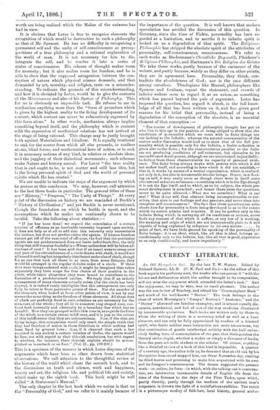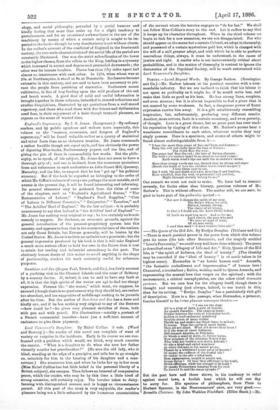CURRENT LITERATURE.
An Old Shropshire Oak. By the late T. W. Warter. Edited by Richard Garnett, LL.D. (C. K. Paul and Co.)—As the editor of this book says in his prefatory note, the reader who can peruse it " with the leisure and deliberation which the author brought to its composition, will not miss the enjoyment which attended the latter's task." And the enjoyment, we may be sure, was no small pleasure. The author was the son-in-law of Southey, and edited his "Commonplace Book" and much of his well-known " Doctor." The book belongs to the class of which Montaigne's " Essays," Burton's " Anatomy," and the " Doctor " aforesaid are familiar examples ; and is almost equally dis- cursive, anecdotical, and full of oat-of-the-way erudition illustrated by innumerable quotations. Such books are written only by those to whom the writing of them is a necessary relief as well as a keen pleasure, and can only be fully appreciated by readers of a kindred spirit, who desire neither mere instruction nor mere amusement, bat that combination of gentle intellectual activity with the half-melan- choly feeling born of contemplation of the past that distinguishes the literary archaeologist, whether a maker or simply a devourer of books, from the pure scientific student or the scholar. Of course, anything like a detailed review of a book of this kind is impossible. A quarter of a century ago, the author tells us, be dreamed that an old oak by his Shropshire homestead stopped him, one drear November day, rustling its dried leaves and promising to make him acquainted with its own and its foregoer's reminiscences. The dream suggested the present work—or, rather, its form—in which, with the talking oak's conversa- tion, are interwoven innumerable details of English life from the time of the Romans to the days of the First Tudor, upon which, partly directly, partly through the medium of the ancient tree's responses, is thrown the light of a multifarious erudition. The result is a picturesque medley of folk-lore, local history, general amine. ology, and social philosophy, pervaded by a genial humour and kindly feeling that more than make up for a slight tendency to garrulousness, and for an occasional awkwardness in the use of the machinery by means of which a certain unity is sought to be im- parted to the book—though its very desultoriness is not without charm. In the author's account of the condition' of England in the fourteenth century, the two main characteristics of the social life of the period are constantly illustrated. One was the strict subordination of the lower to the higher classes, from the villein to the Ring, leading to a tyranny which increased in extent and degree as it proceeded downwards ; the other was its intense localism. Places less than fifty miles apart had almost no intercourse with each other. In 1258, when wheat was at 20e. at Northampton, it stood at 8s. at Dunstable. Enclosures became extensive in this century, and are said to have been necessary to pre- vent the people from perishing of starvation. Enclosures meant cultivation, in lieu of bog-feeding upon the wild produce of the oak and beech woods. A good deal of solid and useful information is brought together in these volumes, imbedded in shrewd reflections and erudite disquisitions, illustrated by apt quotations from a well stored repertory, and those who read them with due leisure and deliberation need fear, in their enjoyment of a keen though tranquil pleasure, no regrets on the score of wasted time.



































 Previous page
Previous page